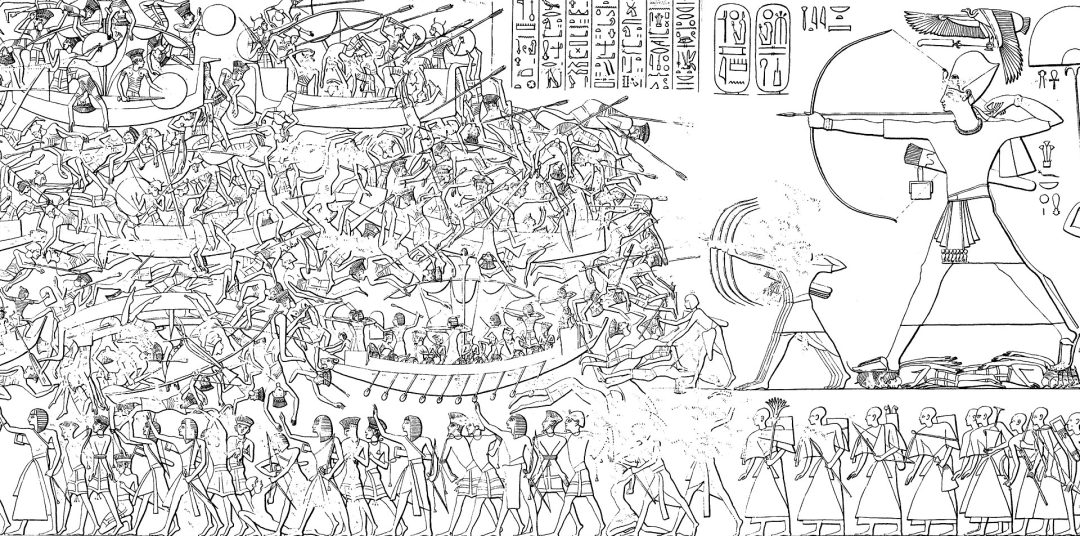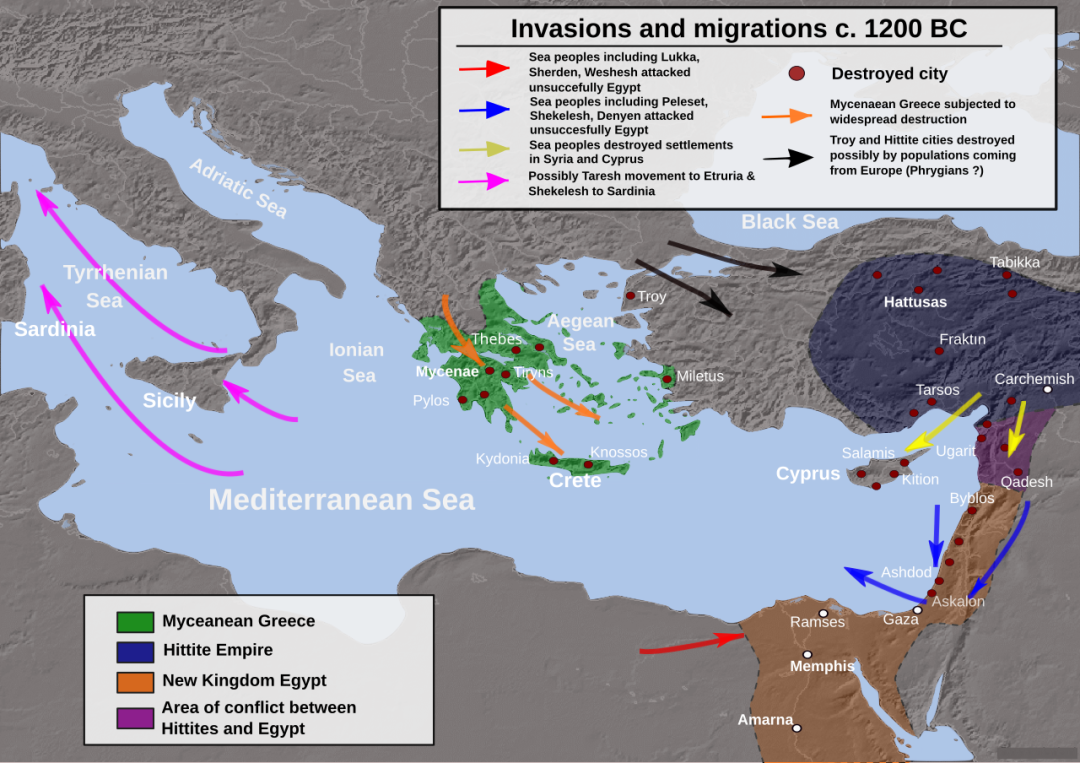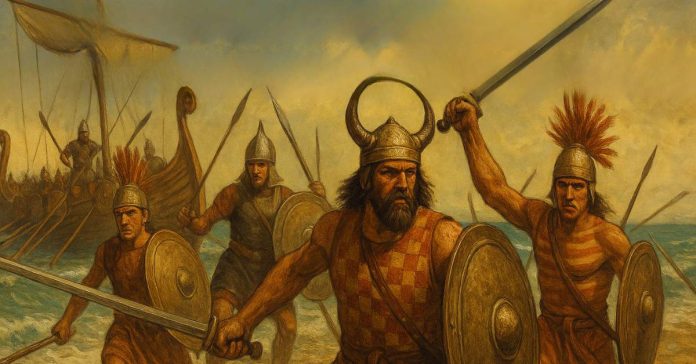The Late Bronze Age (circa 1500–1200 BCE) was a pinnacle of ancient civilization, marked by sprawling empires, advanced trade networks, and cultural flourishing. Yet around 1200 BCE, this interconnected world collapsed abruptly. At the heart of this upheaval were the enigmatic Sea Peoples—a coalition of seafaring groups whose invasions destabilized major powers from Egypt to Anatolia. Egyptian records label the Sea Peoples as “marauding invaders,” and historians frequently attribute the Bronze Age collapse to their actions. Scholars intensely debate their origins, motivations, and eventual fate. This article examines historical, archaeological, and climatological evidence to shed light on one of antiquity’s most enduring enigmas.
The Bronze Age World: A Precarious Balance
During the Bronze Age (circa 3000–1200 BCE), powerful empires rose across the Mediterranean and Near East. Egypt’s New Kingdom, under pharaohs like Ramesses II, built monumental temples and expanded its territory through military campaigns. In Anatolia, the Hittite Empire established its capital at Hattusa. Advanced bronze weaponry and a centralized bureaucracy allowed them to govern vast lands.
Mycenaean Greece flourished with fortified palaces at Mycenae and Pylos. Meanwhile, Levantine city-states like Ugarit thrived as hubs of trade and diplomacy. These civilizations pioneered writing systems: Mesopotamians refined cuneiform for records, Egyptians developed hieroglyphs, and Mycenaeans used Linear B for palace administration.
Merchants and diplomats created extensive trade networks, linking the Mediterranean and Near East. Tin from Anatolia and Afghanistan, essential for bronze production, was exchanged for Egyptian grain, Levantine cedar, and Aegean pottery. Caravans and ships also carried luxury goods like lapis lazuli and ivory, strengthening economic ties.
However, this connectivity brought risks. Disruptions in tin supplies—caused by natural disasters or political instability—could halt bronze production, crippling military and agricultural systems. Regional famines or conflicts triggered cascading crises, destabilizing empires reliant on imports. The collapse of the Hittites, for example, shows how trade failures and environmental stress weakened centralized power, leading to fragmentation.
Environmental and Socioeconomic Pressures
By the 13th century BCE, climatic shifts and natural disasters—earthquakes, prolonged droughts, and famine—strained these civilizations. The Santorini eruption (c. 1600 BCE) and subsequent climatic cooling may have exacerbated resource scarcity, fueling social unrest. Simultaneously, internal weaknesses like dynastic instability, bureaucratic inefficiency, and economic inequality weakened imperial cohesion, setting the stage for collapse.
Who Were the Sea Peoples?

Egyptian inscriptions, particularly those at Ramesses III’s mortuary temple in Medinet Habu, document the Sea Peoples and depict their naval assaults. They comprised at least nine distinct groups: the Peleset, Tjeker, Shekelesh, Sherden, Lukka, Denyen, Teresh, Weshesh, and Eqwesh. Their origins remain disputed. Some scholars link them to Anatolia (e.g., the Lukka, possibly from Lycia) or the Aegean (e.g., the Sherden and Shekelesh, associated with Sardinia and Sicily). Others argue they were a heterogeneous mix of displaced populations fleeing ecological disasters.
Sea Peoples’ Military Campaigns and the Eastern Mediterranean Collapse

Between 1200 and 1170 BCE, the Sea Peoples executed a series of synchronized land and naval campaigns that targeted key power centers across the eastern Mediterranean. Their forces raided and destroyed Ugarit, a thriving port city in modern-day Syria that served as a critical hub for trade between Mesopotamia, Anatolia, and Egypt. They then advanced into Anatolia, sacking the Hittite capital of Hattusa and other urban centers, crippling the empire’s administrative and military infrastructure. Simultaneously, they attacked Cyprus, ravaging coastal settlements and disrupting copper production—a vital resource for bronze manufacturing.
The Sea Peoples’ Invasion of Egypt: The Battle of the Delta
In 1177 BCE, the Sea Peoples launched a massive assault on Egypt, but Pharaoh Ramesses III mobilized his navy and infantry to repel them in decisive battles at the Nile Delta and Djahy (modern Israel). Despite Egypt’s tactical victory, the broader region faced irreversible collapse. The Hittite Empire fragmented into smaller Neo-Hittite states, while Mycenaean palaces in Greece, such as Mycenae and Tiryns, burned to the ground, marking the end of the Aegean Bronze Age.
The Domino Effect: Trade Collapse and Societal Disintegration
This cascade of collapses created a “domino effect” that unraveled centuries-old trade networks. Merchants could no longer rely on secure routes to transport tin from Afghanistan, cedar from Lebanon, or grain from the Nile Valley. Economic paralysis ensued: cities like Ugarit, once bustling with international commerce, lay abandoned, and literacy rates plummeted as scribal schools closed. Populations declined due to famine, displacement, and conflict, plunging the region into a “dark age” characterized by decentralized governance and technological regression. Archaeological evidence from sites like Lachish in Israel and Enkomi in Cyprus reveals abrupt abandonment layers, confirming the widespread societal disintegration.
Theories on Origins and Motivations:
Environmental Migration
A leading hypothesis posits that climate catastrophes—droughts, earthquakes, or the collapse of agricultural systems—forced populations to migrate in search of resources. The Sea Peoples may have been refugees or opportunistic raiders capitalizing on weakened empires.
Social Upheaval and Rebellion
Internal rebellions within Bronze Age societies could have spawned the Sea Peoples. Disenfranchised groups, such as mercenaries (e.g., the Shardana and Lukka, who often served as Egyptian allies), may have turned against their former patrons during economic crises.
Systems Collapse Theory
Archaeologist Colin Renfrew proposed that the Bronze Age’s hyper-interconnectedness created a fragile system. The Sea Peoples’ raids, combined with cascading failures in trade and governance, triggered a systemic collapse akin to a modern economic meltdown.
Legacy and Long-Term Impact
Transition to the Iron Age
The collapse marked the end of palace-based economies and bronze-centric technology. Ironworking, once a secondary craft, became dominant, democratizing tool and weapon production. This shift facilitated the rise of smaller, decentralized states like the Phoenician city-states and early Israelite kingdoms.
Cultural and Religious Shifts
The trauma of collapse may have influenced religious thought. The upheaval weakened traditional polytheistic frameworks, creating space for new theological ideas, including proto-monotheistic movements.
Possible Descendants
The Peleset, one of the Sea Peoples, are often identified as the Philistines of the Hebrew Bible, who settled in coastal Palestine. Archaeological finds, such as distinctive Aegean-style pottery in Philistine cities, support this link.

Conclusion: A Timeless Cautionary Tale
The Sea Peoples remain a haunting symbol of how quickly even advanced civilizations can unravel. Their precise origins are unclear—whether Aegean migrants, Anatolian refugees, or a coalition of displaced groups—but their impact on the ancient world is undeniable. Their invasions triggered the collapse of the Hittite Empire, the downfall of Mycenaean palatial systems, and the fragmentation of Levantine trade networks. This upheaval permanently reshaped the region’s geopolitical landscape.
The turmoil not only marked the end of the Bronze Age but also accelerated technological and cultural shifts. Most notably, it spurred the transition to ironworking. This advancement made tools and weapons more accessible, laying the foundation for decentralized socio-political structures.
The legacy of the Sea Peoples extends far beyond antiquity, offering insights for modern societies. Their story reveals the dangers of systemic vulnerabilities in interconnected systems. Environmental stress, economic fragility, and geopolitical instability can quickly spiral into widespread collapse.
As today’s global networks face similar challenges—climate change, pandemics, and resource scarcity—the Bronze Age collapse serves as a stark warning. It underscores the need for adaptive governance, equitable resource management, and resilience against cascading crises. By studying the Sea Peoples, we are reminded to balance the benefits of globalization with the necessity of sustainability. In this light, the enigmatic marauders of the Late Bronze Age stand not merely as a historical curiosity but as a cautionary tale for the Anthropocene era.
References:
Adams, M. J., & Cohen, M. E. (n.d.). The ‘Sea Peoples’ in primary sources .
Evidence for the origin and movement of Sea Peoples. (2023, December 8).
Exploration mysteries: The Sea Peoples. (2024, June 3). Explorersweb .
The Sea Peoples, from cuneiform tablets to carbon dating. (2011, June 8). PMC .

